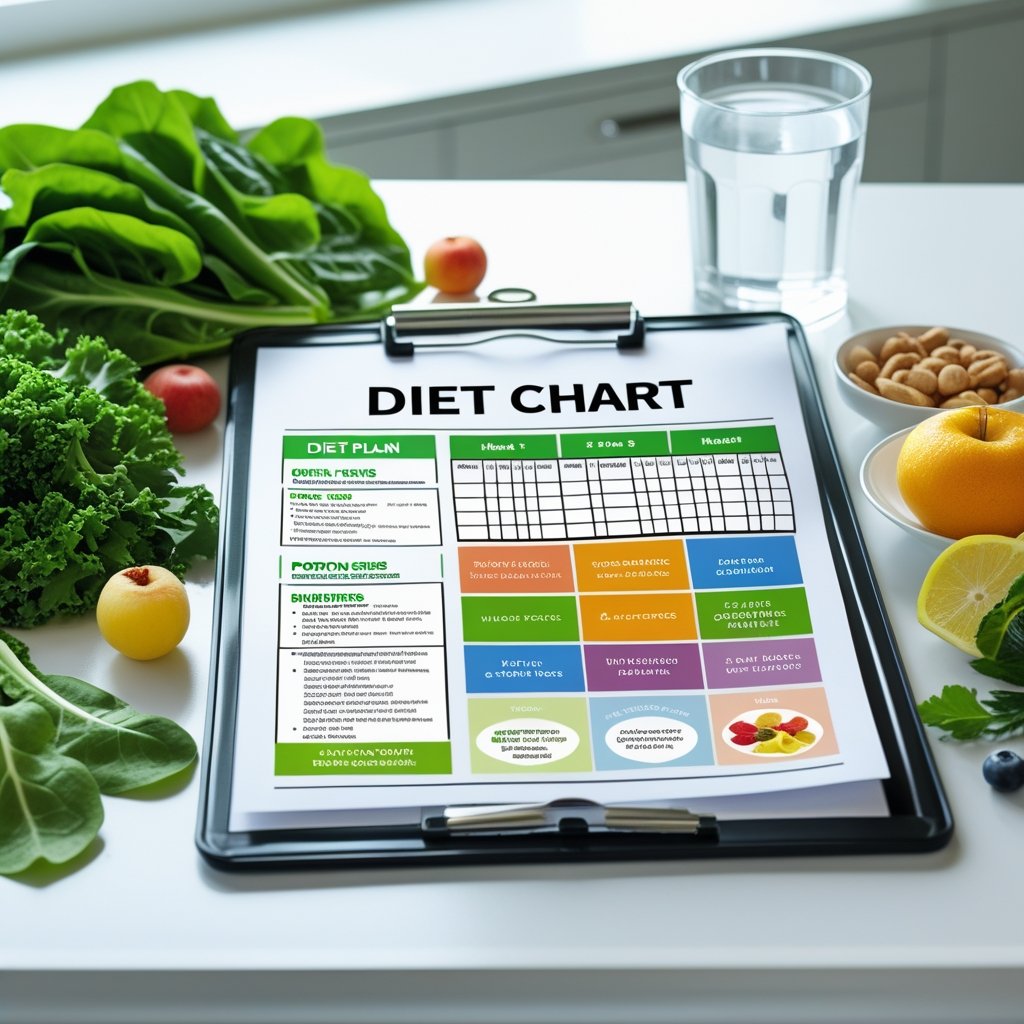Living with diabetes in India can be challenging, especially when it comes to managing your diet amidst a variety of traditional and flavourful foods. However, a well-planned diet is one of the most effective ways to control blood sugar levels and maintain overall health. A thoughtfully designed Diet Chart for Diabetic Patient in India can help you make better food choices without giving up on taste or cultural preferences. In this blog, we’ll guide you through creating a balanced Indian meal plan, highlight the best foods to include, and share practical tips to help you enjoy your favourite dishes while keeping your diabetes in check. Whether you’re newly diagnosed or seeking to refine your eating habits, this comprehensive guide will support you in your journey towards healthier living.
Introduction
Diabetes is a growing health concern in India, affecting millions of people across all age groups. With rapid urbanization, changing lifestyles, and dietary habits, the prevalence of diabetes—especially Type 2 diabetes—has reached alarming levels. According to the International Diabetes Federation, India is home to over 77 million diabetics, making it the diabetes capital of the world.
Managing diabetes effectively is crucial to prevent complications and maintain a good quality of life. While medication and exercise play important roles, diet is the cornerstone of diabetes management. The right food choices can help regulate blood sugar levels, boost energy, and support overall well-being.
In this comprehensive guide, we’ll explore the best dietary practices for diabetics in India, offer a sample Indian diet chart, share practical tips, and answer common questions. Whether you’re newly diagnosed or seeking to optimize your diabetes care, this article will give you actionable insights and a realistic meal plan tailored to Indian tastes and ingredients.
Understanding Diabetes and Its Dietary Needs
What is Diabetes?
Diabetes is a chronic condition characterized by high blood sugar (glucose) levels. It occurs when the body either does not produce enough insulin (a hormone that helps glucose enter the cells) or cannot use insulin effectively. There are two main types:
- Type 1 Diabetes: The body produces little or no insulin.
- Type 2 Diabetes: The body becomes resistant to insulin or doesn’t produce enough. This is the most common type in India.
How Diet Affects Blood Sugar
Every food you eat has an impact on your blood sugar. Carbohydrates (found in grains, fruits, dairy, etc.) have the most significant effect, as they break down into glucose. Proteins and fats affect blood sugar less directly but are still important for overall health.
A balanced diet helps:
- Maintain stable blood sugar levels
- Prevent spikes and crashes
- Support weight management
- Reduce the risk of complications
Indian Dietary Habits and Cultural Context
Indian cuisine is diverse and flavorful, but it often includes high amounts of carbohydrates (rice, wheat, potatoes), sugary sweets, and fried foods. Adapting traditional recipes and making mindful choices is essential for effective diabetes management.
Key Principles of a Diabetic Diet
1. Balanced Nutrition
A diabetes-friendly diet should include:
- Complex Carbohydrates: Whole grains, millets, legumes
- Lean Proteins: Paneer, tofu, fish, eggs, chicken, dals
- Healthy Fats: Nuts, seeds, olive oil, mustard oil
- Plenty of Vegetables: Especially leafy greens and non-starchy veggies
- Low-Sugar Fruits: Apples, guava, papaya, berries
2. Glycemic Index (GI)
The Glycemic Index measures how quickly foods raise blood sugar. Low-GI foods (like whole grains and legumes) cause a slow, steady rise, while high-GI foods (white rice, potatoes, sweets) cause spikes. Opt for low- and medium-GI foods.
3. Portion Control and Meal Timing
- Eat smaller, frequent meals (every 3-4 hours)
- Avoid skipping meals to prevent sudden drops or spikes in blood sugar
- Control portion sizes, especially for carbohydrates
4. Hydration and Lifestyle
- Drink plenty of water (8-10 glasses/day)
- Limit sugary drinks and juices
- Include regular physical activity (walking, yoga, cycling)
- Get adequate sleep and manage stress
Foods to Eat and Avoid for Diabetic Patients in India
Foods to Eat
Whole Grains:
- Brown rice, millets (ragi, bajra, jowar), whole wheat, oats, quinoa
Legumes and Pulses:
- Moong dal, chana dal, rajma, chole, masoor dal
Vegetables:
- Spinach, methi, bottle gourd (lauki), bitter gourd (karela), beans, carrots, cucumber, tomatoes, broccoli
Low-Sugar Fruits:
- Guava, apple, papaya, pears, oranges, strawberries
Lean Proteins:
- Paneer, tofu, eggs, fish, chicken (grilled or baked), sprouts
Healthy Fats:
- Almonds, walnuts, flaxseeds, chia seeds, olive oil, mustard oil
Dairy:
- Low-fat milk, curd, buttermilk
Foods to Avoid
Refined Grains:
- White rice, maida-based products (white bread, bakery items)
Sugary Foods and Drinks:
- Sweets (mithai), desserts, sugar-laden beverages, packaged juices, soft drinks
Deep-Fried Foods:
- Samosa, pakora, puri, bhatura
High-GI Fruits:
- Mango, banana, grapes, chikoo, jackfruit
Processed and Packaged Foods:
- Chips, biscuits, instant noodles, ready-to-eat snacks
Alcohol and Smoking:
- Limit or avoid, as they can affect blood sugar and overall health
Sample Indian Diet Chart for Diabetic Patients

A well-planned meal schedule can help maintain consistent blood sugar levels. Here’s a sample diet chart tailored for Indian diabetics:
Early Morning (6:30 – 7:00 AM)
- 5-6 soaked almonds or 1 tablespoon flaxseeds
- 1 glass warm water with 1 teaspoon methi (fenugreek) seeds soaked overnight
Breakfast (8:00 – 8:30 AM)
- 1-2 vegetable moong dal chilla or oats upma
- 1 small bowl low-fat curd
- 1 cup unsweetened green tea or black coffee
Mid-Morning Snack (10:30 – 11:00 AM)
- 1 small apple or guava
- 1 glass buttermilk (chaas) or coconut water
Lunch (1:00 – 1:30 PM)
- 2 whole wheat rotis or 1 cup brown rice
- 1 medium bowl dal or rajma/chole (without cream)
- 1 serving mixed vegetable sabzi (cooked with minimal oil)
- 1 small bowl salad (cucumber, tomato, carrot, beetroot)
- 1 cup plain curd
Afternoon Snack (4:00 – 4:30 PM)
- 1 small bowl sprouts chaat (with onion, tomato, coriander, lemon)
- Herbal tea or lemon water
Evening Snack (6:00 – 6:30 PM)
- 1 roasted chana or handful of nuts (almonds/walnuts)
- 1 cup herbal tea
Dinner (8:00 – 8:30 PM)
- 2 small multigrain rotis or 1 cup millet khichdi (bajra, jowar, or ragi)
- 1 bowl lightly sautéed or steamed mixed vegetables (lauki, tinda, spinach, beans, carrots)
- 1 small bowl dal or moong dal soup
- Fresh salad (cucumber, radish, tomato)
Bedtime Snack (10:00 PM)
- 1 cup warm, low-fat milk (unsweetened) or a small handful of nuts (walnuts, almonds)
Note:
Adjust portion sizes based on your age, gender, activity level, and specific health needs. Always consult your doctor or a registered dietitian before making significant changes to your diet.
Indian Diabetic-Friendly Recipes
Eating healthy doesn’t mean giving up on taste! Here are a few simple and delicious Indian recipes suitable for diabetics:
1. Oats Idli
- Ingredients: Oats, rava (semolina), curd, grated carrot, mustard seeds, curry leaves.
- Preparation: Dry roast oats and rava, mix with curd and veggies, season, and steam as idlis.
- Benefits: High in fiber, low GI, filling breakfast option.
2. Palak Dal
- Ingredients: Moong dal, spinach, onion, tomato, garlic, cumin.
- Preparation: Pressure cook dal with spinach, sauté with spices, and serve with roti.
- Benefits: Rich in protein and iron, low in calories.
3. Sprouts Chaat
- Ingredients: Mixed sprouts, onion, tomato, cucumber, lemon juice, coriander.
- Preparation: Mix all ingredients, season with salt and pepper, and serve.
- Benefits: Packed with protein, fiber, and vitamins.
4. Lauki (Bottle Gourd) Sabzi
- Ingredients: Lauki, tomatoes, ginger, cumin, turmeric, coriander powder.
- Preparation: Sauté spices, add lauki and tomatoes, cook until soft.
- Benefits: Low calorie, hydrating, easy to digest.
5. Vegetable Upma
- Ingredients: Rava, mixed vegetables (beans, carrots, peas), mustard seeds, curry leaves.
- Preparation: Roast rava, sauté veggies and spices, add water and cook.
- Benefits: Balanced meal with fiber and vitamins.
Tips for Eating Out and Social Gatherings
Diabetes management isn’t limited to home-cooked meals. Here’s how you can make healthier choices when eating out or attending social functions:
- Plan Ahead: Review the menu and choose grilled, baked, or steamed dishes over fried items.
- Control Portions: Share dishes or ask for half portions; avoid second helpings.
- Skip Sugary Drinks: Opt for water, buttermilk, or unsweetened beverages.
- Start with Salad: Fill up on fiber-rich salads before the main course.
- Watch Hidden Sugars: Ask about sauces and dressings; many contain added sugar.
- Limit Sweets: Politely decline or take a very small portion if you wish to taste.
Frequently Asked Questions (FAQs)
1. Can diabetics eat rice?
Yes, but in moderation and preferably brown rice or millets, which have a lower glycemic index than white rice. Always pair rice with plenty of vegetables and protein to slow glucose absorption.
2. What are the best Indian snacks for diabetes?
Healthy options include roasted chana, sprouts salad, vegetable upma, moong dal chilla, and a handful of nuts or seeds.
3. How to control sugar cravings?
Eat small, frequent meals with a balance of protein and fiber. Choose low-sugar fruits and cinnamon to add sweetness naturally. Stay hydrated and avoid skipping meals.
4. Can I eat fruits if I have diabetes?
Yes, but choose low-sugar fruits like guava, apple, papaya, and berries. Limit high-sugar fruits like mango, banana, and grapes.
5. Is it necessary to avoid all fats?
No, healthy fats like those from nuts, seeds, and olive oil are beneficial in moderation. Avoid trans fats and limit saturated fats.
Expert Tips and Lifestyle Advice
1. Exercise Regularly
Aim for at least 30 minutes of moderate activity (walking, cycling, yoga) most days of the week. Physical activity improves insulin sensitivity and helps control blood sugar.
2. Monitor Your Blood Sugar
Check your blood sugar levels as advised by your doctor. Keeping a diary can help you identify patterns and triggers.
3. Manage Stress
Chronic stress can raise blood sugar levels. Practice meditation, deep breathing, or hobbies you enjoy.
4. Get Enough Sleep
Aim for 7-8 hours of restful sleep. Poor sleep can disrupt blood sugar control.
5. Stay Hydrated
Drink plenty of water and avoid sugary drinks.
6. Work with a Professional
Consult a registered dietitian or diabetes educator for personalized advice and support.
Printable/Downloadable Indian Diet Chart
Here’s a sample Indian diet chart for diabetics
| Time | Meal/Item |
|---|---|
| Early Morning | Soaked almonds, methi water |
| Breakfast | Moong dal chilla or oats upma, low-fat curd |
| Mid-Morning | Small apple or guava, buttermilk |
| Lunch | 2 rotis (whole wheat), dal, sabzi, salad, plain curd |
| Afternoon Snack | Sprouts chaat, herbal tea |
| Evening Snack | Roasted chana or nuts, herbal tea |
| Dinner | 2 multigrain rotis or millet khichdi, vegetable sabzi, dal, salad |
| Bedtime | Warm low-fat milk or handful of nuts |
Conclusion
Managing diabetes doesn’t mean giving up on delicious Indian food. With mindful choices, balanced meals, and a little planning, you can enjoy a varied diet that keeps your blood sugar in check and supports your overall health. Remember, consistency is key—stick to your meal timings, watch your portions, and stay active.
Diabetes care is a lifelong journey, but with the right diet and lifestyle, you can lead a full, active, and healthy life. If you’re ever in doubt, consult your healthcare provider or a qualified dietitian for personalized guidance.
References and Further Reading
- International Diabetes Federation
- Indian Council of Medical Research – Diabetes Guidelines
- Pharmaheals Diabetes Resources
- Asian Heart Institute – Diabetes Blog
Take the First Step Toward Better Diabetes Management
Managing diabetes is a holistic journey that involves not just medication, but also consistent lifestyle modifications and proactive dietary choices. Remember, there is no “one-size-fits-all” diet. Listen to your body, monitor your blood sugar regularly, and don’t hesitate to seek professional help for a plan that suits your unique needs.
Small steps, big difference:
- Start by making one healthy swap at a time—replace white rice with brown rice or millets, choose roasted snacks over fried ones, and add more vegetables to every meal.
- Keep a food diary to track what works best for your body.
- Engage your family in your health journey—healthy eating benefits everyone!
Share Your Experience
Have you tried a diabetes-friendly Indian diet? Do you have favourite recipes or tips to share with others? Leave a comment below! Your experience can inspire and help many others on a similar path.
Download Your Free Indian Diabetic Diet Chart
To help you get started, download our printable Indian diet chart for diabetics here. Stick it on your fridge or save it on your phone for easy reference!
Final Thoughts
Living with diabetes in India can be challenging, given our love for food and social gatherings. But with mindful eating, smart swaps, and the support of family and healthcare professionals, you can absolutely enjoy Indian cuisine while keeping your blood sugar in check.
Remember:
- Focus on whole, unprocessed foods.
- Prioritize fiber, protein, and healthy fats.
- Limit refined carbs, sugar, and fried foods.
- Stay active and hydrated.
- Monitor your health regularly.
Your journey to better health begins with your next meal. You’ve got this!
If you found this guide helpful, please share it with friends and family who might benefit. For more tips, meal plans, and healthy recipes, subscribe to our newsletter.
Stay healthy, stay happy!
Disclaimer: This article is for informational purposes only and is not a substitute for professional medical advice. Always consult your doctor or a registered dietitian for personalized guidance.




Pingback: Attar Ayurveda Jamun Seed Powder Review: Best Diabetes Aid? - Pharma Heals
Pingback: Dates & Diabetes: Glycemic Impact, Benefits, and Safe Use - Pharma Heals
Pingback: Is Papaya Good for Diabetes: Evidence-Based Benefits and Blood Sugar Impact - Pharma Heals